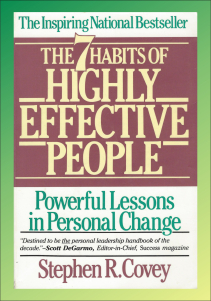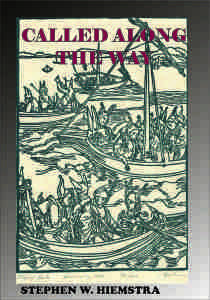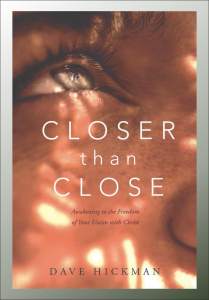Stephen W. Hiemstra's Blog, page 241
August 23, 2016
Covey Teaches Good Habits
 Stephen R. Covey. 1989. The 7 Habits of Highly Effective People: Restoring the Character Ethic. New York: Simon and Schuster; Fireside Book.
Stephen R. Covey. 1989. The 7 Habits of Highly Effective People: Restoring the Character Ethic. New York: Simon and Schuster; Fireside Book.
Review by Stephen W. Hiemstra
So much of the time, we want God to solve our problems and to clean up our messes that we should be working on ourselves. Working as a chaplain intern in the emergency department, I started to notice that about half the patients that I saw daily came in complaining of medical problems arising from poor lifestyle choices—addictions, risky sexual practices, obesity related illnesses, and stress related illnesses. When I mentioned my observation to the head surgeon, he corrected me—it was not half the patients, it was three-quarters of them. If we perform so poorly in taking care of our physical bodies, what does that say about our performance in our relationships and careers? (And our need for God…)
In his book, The 7 Habits of Highly Effective People, Stephen Covey presents: “a holistic, integrated approach to personal and interpersonal effectiveness.” (9) Effectiveness here means that the biblical teaching is boiled down into principles for living and working effectively, without necessarily understanding how those principles came to be. Since God is sovereign over the whole universe, the principles of the universe are, of course, also his. In this case, Covey is a Harvard MBA with a doctorate from Brigham Young University (a Mormon school) where, at the time of publication, was also a faculty member in the Marriott School of Management.
Covey starts with a lengthy introduction where he distinguishes personality from character, writing:
“In stark contrast, almost all of the literature [on how to be successful in life and career] in the first 150 years or so focused on what could be called the Character Ethic as the foundation of success—things like integrity, humility, fidelity, temperance, courage, justice, patience, industry, simplicity, modesty, and the Golden Rule….
But shortly after World War I the basic view of success shifted from the Character Ethic to what we might call the Personality Ethic. Success became more a function of personality, of public image, of attitudes, and behaviors, skills, and techniques, that lubricate the processes of human interaction.” (18-19)
Covey then goes on to say that the elements of the Personality Ethic are certainly important, they are also second traits; the elements of the Character Ethic, by contrast, are primary traits (21-23). Being primary means that they not only affect our habits profoundly, they also affect our very perception of the world—our worldview or, more importantly, the lens that we use to interpret the things we see and experience (24-31). “Being is seeing” he says (32) His seven habits therefore focus on these primary traits. Covey summarizes saying:
“The Character Ethic is based on the fundamental idea that there are principles that govern human effectiveness—natural laws in the human dimension that are just as real, just as unchanging and unarguably ‘there’ as laws such as gravity are in the physical world.” (32)
To make his point, Covey tells the story of a confrontation on a foggy day between an arrogant battleship captain and a lighthouse attendant over who would change course. Who do you suppose ended up changing course? Sometimes, knowing the difference between objective and subjective reality is a matter of life and death, and arrogance is not an option—to be effective we must be willing to start by reforming ourselves and listening to those around us. (33, 37, 42)
Covey defines:
“a habit as the intersection of knowledge, skill, and desire. Knowledge is a theoretical paradigm, the what to do and the why. Skill is the how to do. And desire is the motivation, the want to do. In order to make something a habit in our lives, we have to have all three.” (47)
Covey drives his point home with a Venn diagram showing the intersection of three circles (knowledge, skill, and desire) with habits occupying the intersection of the three circles (48).
Covey does not see effective people working alone; rather, effective people involve the people around them in what he refers to as the maturity continuum, writing:
“On the maturity continuum, dependence is the paradigm of you—you take care of me; you come through for me; you didn’t come through; I blame you for the results.
Independence is the paradigm of I—I can do it; I am responsible; I am self-reliant; I can choose.
Interdependence is the paradigm of we—we can do it; we can cooperate; we can combine our talents and abilities and create something greater together.” (49)
While it is obvious that team-work is required in any large scale project, Covey makes an observation that is less obvious:
“Interdependence is choice only independent people can make. Dependent people cannot choose to become interdependent. They don’t have the character to do it; they don’t own enough of themselves.” (51)
Unable to control themselves, dependent people cannot perform well in teams; only independent people are free to join teams, not threatened by working harmoniously with others. Consequently, Covey sees the 7 habits of highly effective people including both individual character traits (independent people) and relational characteristics (teamly attitudes). Covey’s seven habits therefore are:
“Be proactive.
Begin with the end in mind.
Put first things first.
Think win/win.
Seek first to understand, then to be understood.
Synergize.
Sharpen the saw.” (53)
Covey lays out his approach in part one of this book, which includes two sections. He then writes the heart of his books in chapters for each of the seven habits. These chapters are preceded by acknowledgements and followed by several appendices and indices.
Stephen Covey’s The 7 Habits of Highly Effective People has educated a generation of business and church leaders on how to be effective in working within organizations. Early in my government career, I read this book and I spent much of the rest of my career reaping the benefits. It is hard to accurately access the fruit of Covey’s insights and his habits have each spawned books elaborating his habits, even if unknowingly. Read and study the book—both you and your colleagues will be glad that you did.
August 21, 2016
42. Prayers of a Life in Tension by Stephen W. Hiemstra
 Lord Most High,
Lord Most High,
Forgive us for sins known and unknown, transgressions flaunted, and iniquities seen and unseen. Give us penitent hearts that repent and make amends seeking justice, not just quiet absolution. Transform our lives, Oh Lord, that we might become fit stewards of grace. Let us put on the full righteousness of Christ as knights suiting up for battle that we might extend your kingdom into hearts yet unrepentant and minds shielded from grace. May our lives always speak louder than our words and our words speak only of you. Not squelching your Holy Spirit, but giving your spirit full reign, centered on you and you alone. In Jesus’ name, Amen.


August 19, 2016
Boundaries
 “And you shall not go up by steps to my altar,
“And you shall not go up by steps to my altar,
that your nakedness be not exposed on it.”
(Exod 20:26 ESV)
Boundaries
By Stephen W. Hiemstra
Early in January 1983, I finished the last interviews that I had planned for my dissertation project, which had kept me busy for the previous six months. My dissertation eventually was entitled—Labor Relations, Technological and Structural Changes in U.S. Beef Packing and Retailing (1985)—but at that point I just returned from driving all over the the mid-west and as far west as Colorado visiting companies and their union representatives. At the time, cattle slaughtering plants all over the Eastern Corn Belt were being shut down, usually after a lengthy strike, due to competition from integrated cattle slaughtering and beef processing plants on the high plains, especially Nebraska, Kansas, and Texas. Managers and union officials were eager to tell the story of their plant; how they had worked there for their entire career; and how the plants were now being shut down and being sold for scrap. The integrated plants kept humming along, located next to enormous cattle feedlots with tens of thousands of head of cattle and employing immigrant workers from far away places, who lived in trailer parks, spoke no English, and were members of union from outside the meat packing industry.
My interviews were both fascinating and deeply disturbing, as I had a front row seat observing the merger of two industries—cattle slaughter and beef processing—creating enormous, new efficiencies in production and eliminating large numbers of highly paid, blue-collar union jobs. And having returned from my adventure in technological change, I found my own funding cut off before I was able to even write down my experiences.
Classmates a year or two ahead of me interviewed for teaching positions, started work, and finished their dissertation projects while working on their new jobs. In my case, I interviewed successfully with the University of Hawaii, who found my master’s research on Puerto Rican agriculture directly pertinent to their own agricultural research. When push came to shove, however, a friend of mine with no such experience was offered the position because he was presumably closer to finishing his dissertation.[1] Worse, a year later when I reached the same point, cutbacks in funding announced by the Reagan Administration led the land grant universities to curtail their hiring altogether. Much of the research previously done in the universities was federally funded through cooperative agreements that were cut and never again funded, leading the field of agricultural economics into a long term decline.
With my grant money cut, I had to leave Michigan State University without finishing my dissertation. Normally, doctoral students who leave campus never return and the rule of thumb is that about two-thirds of the doctoral candidates never complete the dissertation. Some of these students actually list their degree as ABD, “all but dissertation”; others simply quietly suffer ridicule the rest of their careers. No one expected me to return from Northern Virginia where I moved back in with my parents for the first time in about a decade.
The hard times continued at home. The Reagan Administration announced arbitrary, back-to-back hiring freezes on federal agencies, including the USDA office that wanted to hire me. Without a job or any prospect of a job, I lived in my parent’s basement and worked days to type my dissertation on my father’s manual typewriter. I ventured outside the house once a week to have lunch with our associate pastor, who considered me a good prospect for his counseling business, and occasionally to interview for different USDA offices hoping to be able to hire at some point.
The last pay period of 1983, I finally was able to start work in USDA—the timing was a godsend because the Reagan Administration introduced a much less generous retirement system on January 1, 1984. In USDA, I was encouraged to join the World Trade Branch (WTB) in International Economics Division where my old supervisor was the new branch chief. WTB focused on developing and maintaining international agricultural trade statistics. My new supervisor offered me several projects to choose from, but I chose to work with an old friend, who had been a branch chief but was pushed out with the change of administrations. I owed him a favor and hoped that I could help him improve his standing within the group.
The project involved reconciling bilateral trade statistics (country to country trade figures published by the United Nations) with the Food and Agricultural Organizations (FAO) summary statistics on trade with the world (total exports and total imports), which were considered the more reliable numbers. An export table, for example, would list the country in focus, total exports reported by the FAO, and all the destinations where a particular commodity, like wheat, corn, or soybeans, would be exported. My friend spent the previous year reconciling all the countries of the world for only one commodity, wheat, because he needed to hunt up these export destinations manually in each country’s trade statistics books. He had lots of trade statistics books in his office.
I spent about a month reconciling trade statistics by hand before I began having second thoughts about my choice of projects. As my mind wandered one morning, I realized that these tables that I was filling in with country yearbook statistics were all computer printouts. If the figures were all in computer files, then the numbers could be reprogrammed to reduce the amount of manual labor required to complete the tables because we had two estimates for most trades: the export reported by one country and the import reported by their trading partner. Comparing those two estimates, we would be able to identify both trans-shipments and missing data, which would be a really big deal because during the Cold War many countries tried to hide their trade, particularly with Communist countries. The United States, for example, embargoed trade with Cuba back then, but making such comparisons would allow us to identify cheaters among our trading partners. I checked with our computer staff, verified the existence of these data, and, then, approached management with a proposal to automate the construction of review tables. Management was intrigued and I was given a few weeks to see what could be done.
I was encouraged to learn a new computer language called SAS and spent a month deciphering the SAS documentation. Everything was done on an IBM 370 computer which meant that I also had to learn to program in Job Control Language (JCL) and, later, to manage a series of SAS programs with a CLIST script. In the end, I had a menu driven system for managing trade statistics that USDA continued to use for more than a decade. The analytical side of the project was published as a Foreign Agricultural Economics Report—Methods of Reconciling World Trade Statistics—from which we garnered an invitation for our team to travel to Rome, Italy to brief the FAO, which we had to turn down, and a briefing later for the Central Intelligence Agency, who was interested in using our procedures for tracking contraband trade more generally.
This automation of a manual processes was an important theme during the Reagan Administration, which was especially interested in administrative efficiency. Large databases throughout the government are maintained by the information technology groups, but oftentimes are poorly understood by other staff tasked with research and administration. In order for technology to improve productivity, data systems need to be understood well enough by other staff that procedures can be integrated with the data.[2] In order to take full advantage of the automation, regulations and procedures may need to be updated and staff retrained, a process that could take years even if it were a priority. Because such changes are not usually a priority, professional groups that may be disadvantaged by the change have enormous incentive to resist the change. Secretaries may not want to learn to use a word processing program; analysts may not want to learn a new spreadsheet program; programmers may not want other staff learning to program. Nevertheless, success in this project required transgressing administrative and professional boundaries, which was not always appreciated or tolerated.
In my case, the data system that I developed yielded about half a dozen publications (see reference citations) and the invitations cited above before I was promoted and offered a very interesting job in my old office—Western European Branch. Being outside of trade and already well-published, completing my dissertation and receiving my doctorate had no tangible effect on salary or my government career until much later.
REFERENCES
Hiemstra, Stephen W. 1985. “U.S. Share of World Rice Market Declines,” Rice: Outlook and Situation. U.S. Department of Agriculture (USDA). Economic Research Service (ERS). March.
Hiemstra, Stephen W. 1985. “U.S. Share of the World Wheat Market Declines,” Wheat: Outlook and Situation. USDA. ERS. May.
Hiemstra, Stephen W. 1985. “U.S. Share of World Wheat Flour Market Declines,” Wheat: Outlook and Situation. USDA. ERS. September.
Hiemstra, Stephen W. 1986. “U.S. Farm Exports to EC Continue Falling,” Foreign Agricultural Trade of the United States. USDA. ERS. November/December.
Hiemstra, Stephen W. and Arthur B. Mackie. 1986. Methods of Reconciling World Trade Statistics. USDA. ERS. Foreign Agricultural Economics Report No. 217. May.
[1] As it turned out, he never finished his degree. He did not possess the “killer instinct”.
[2] Many administrative procedures were developed in the 1960s in the Kennedy Administration, well before automated systems were widely available, and agency regulations codified in the Federal Register during that period.


Kindle Sale 99 Cents: A Christian Guide to Spirituality (last day of sale)
Kindle Sale 99 Cents: A Christian Guide to Spirituality

Available on Amazon.com
August 13 through August 20, 2016
Purchase now (Click here)
Learn more (Click here)
Check out today’s ad: (Click here)
Hear the words; walk the steps; experience the joy!


August 16, 2016
Hickman Explains God’s Presence
 Dave Hickman. 2016. Closer than Close: Awakening to the Freedom of Your Union with Christ. Colorado Springs: NavPress.
Dave Hickman. 2016. Closer than Close: Awakening to the Freedom of Your Union with Christ. Colorado Springs: NavPress.
Review by Stephen W. Hiemstra
Since I graduated from seminary in October 2013, I have spent increasing time working as an author alone. In my early seminary years, I was working as an economist full-time and traveling to classes once a month; later when I retired from government, I traveled to classes twice a month. Before and during seminary, I was a perpetual motion machine; now, I am still busy, but now I am busy alone. What’s different? I now longer feel a need to have music playing—I am content to work and live in silence. I share my day with God and am mostly at peace, even in the midst of daily chaos.
David Hickman, in his book, Closer than Close, writes:
“After years of striving to be close to Jesus, I stumbled upon the shocking reality that Jesus was already as close to me as he could possibly get. It was then that I discovered, in the words of Philip Yancey, ‘Jesus I never knew.’ Striving was replaced with abiding.” (xv)
When Jesus talks in the seventh Beatitude—Blessed are the peacemakers, for they shall be called children of God (Matt 5:9), he is referring to the Jewish concept of shalom, where shalom (שָׁלוֹם) means “completeness, soundness, welfare, peace” (BDB 10002) and not the more limited idea of reconciliation, which we are more familiar with. This is why Hickman can say: “union with Christ has long been considered to be the central message of the Gospel” (xxvi) embodied in the word abiding and in the idea of being children of God—we are all brothers and sisters of our father in heaven.
Stilling, abiding is more than being members of God’s family. Hickman writes:
“What if the union I longed to have with my son was but a pale reflection of a ‘oneness’ I always longed to have with Jesus? What if Jesus never wanted to have a ‘close relationship’ with me? What if he always wanted to be ‘one’ with me instead?” (18)
This abiding is not a new idea, it is a very old idea that has its roots in the unity of God in the Shema (25-26):
“Hear, O Israel: The LORD our God, the LORD is one. You shall love the LORD your God with all your heart and with all your soul and with all your might.” (Deut 6:4-5)
In some sense, the abiding idea in the Gospel of John is a reflection of the unity modeled by the Trinity:
“Abide in me, and I in you. As the branch cannot bear fruit by itself, unless it abides in the vine, neither can you, unless you abide in me. I am the vine; you are the branches. Whoever abides in me and I in him, he it is that bears much fruit, for apart from me you can do nothing. If anyone does not abide in me he is thrown away like a branch and withers; and the branches are gathered, thrown into the fire, and burned. If you abide in me, and my words abide in you, ask whatever you wish, and it will be done for you.” (John 15:4-7)
Obviously, Hickman wanders into the deep end of the pool here—I know that in my own experience, this sort of relationship with God “just is” and is hard to talk about it when people ask. How do you talk about the most intimate relationships with anyone else? It feels like something between bragging and betraying a confidence.
Hickman’s discourse on the union with God is organized, in part, around the meta-narrative of the Bible: creation, fall, redemption, and new creation. However, he recasts the biblical narrative in terms of union, disunion, reunion, and promise of perfect union (48). Stated in this way, our union with God is both modeled after the Trinity and modeled into our faith journey.
While there are many aspects of theology that could be discussed, I found Hickman’s implication for the spiritual disciplines the most interesting. He summarizes his comments under four topics: doing nothing, praying simply, staying attentive, and being led (104). Let me focus on each in turn.
Doing Nothing. Hickman writes: “it takes more faith to believe we are loved and accepted by God when we are doing nothing than when we are doing as much as we can for God.” (105) Repeat that ten times. Our salvation depends wholly on the work of Christ and does not depend on anything that we have done. Hickman uses the example of a child in the womb—the body of the child matures naturally as the child abides in the mother’s womb and has nothing to prove or do (107). This concept of abiding in Christ immediately affects our attitude about prayer.
Praying Simply. Hickman makes a profound statement: “prayer is more about who we are praying to than what we are saying.” (109) Again, he draws on an analogy to one of his children who, before he could speak, asked for a bagel by pointing to the bagel and then pointing to his mouth (113). Prayer is like a child pointing at things that are needed throughout the day.
Staying Attentive. Hickman notes that “the question is not whether God is fully present in our lives, but if we are living fully aware of God’s presence.” (115) Of course, sometimes God needs to draw our attention a bit more dramatically than usual, because of our inattention. Hickman refers to these as “love letters” from God (115).
Being Led. Hickman describes spiritual direction as: “The discipline of being led [which] involves the willingness to entrust yourself to someone else’s care.” (124) Spiritual direction is not counseling; it is not teaching; it involves having someone point to God’s work in your life and helping you find your true self in Christ.
David Hickman’s book, Closer than Close, is a fascinating exposition of the nature of God’s union with us, a relationship which is discussed in the New Testament but seldom discussed in any detail elsewhere. In my case, Closer than Close gave me a framework for discussing my own faith journey. Words matter. If you are serious about your faith, then this book is for you.
REFERENCES
Brown-Driver-Briggs-Gesenius (BDB). 1905. Hebrew-English Lexicon, unabridged.
I have sometimes talked about God’s little Easter Eggs in reference to scientific discoveries that God has placed in our path so that we would find them. Hickman’s love letters is a bit more general idea focused on God’s revealing of himself.


August 15, 2016
Kindle Sale 99 Cents: A Christian Guide to Spirituality (New ad online)
Kindle Sale 99 Cents: A Christian Guide to Spirituality

Available on Amazon.com
August 13 through August 20, 2016
Purchase now (Click here)
Learn more (Click here)
Check out today’s ad: (Click here)


August 14, 2016
41. Prayers of a Life in Tension by Stephen W. Hiemstra
 Almighty and Compassionate Father,
Almighty and Compassionate Father,
The Bible says that through the power of the Holy Spirit, we are to become witnesses to our neighbors, the region, and to the whole world (Acts 1:8). Convict us, Lord, that our witness reaches all in need.
The Bible says that Saul approved of Stephen’s execution and afterwards a great persecution arose (Acts 8:1). And that many churches were founded as the disciples were scattered by the Holy Spirit (Acts 11:19). And even the grand persecutor himself, Saul of Tarsus, was himself transformed into an evangelist who we know as Paul (Acts 9:5). Convict us, Lord, that our witness reaches all in need.
Grant us the mind of Christ, we might focus on your priorities, not our own. Transform ours hearts that we might feel the things that you feel, not feelings of our own. That on the day of judgment, we will be judged according to Christ’s righteousness, not our own. In the power of your Holy Spirit, give us eyes that see and ears that hear and feet that obey. In Jesus’ precious name, Amen.


August 13, 2016
Kindle Sale 99 Cents: A Christian Guide to Spirituality
Kindle Sale 99 Cents: A Christian Guide to Spirituality

Available on Amazon.com
August 13 through August 20, 2016
Purchase now (Click here)
Learn more (Click here)


August 12, 2016
The Killer Instinct
“Go to the ant, O sluggard; 
consider her ways, and be wise.”
(Prov 6:6)
The Killer Instinct
By Stephen W. Hiemstra
In my first professional job as an economist, I interned with the Economic Research Service (ERS) in the U.S. Department of Agriculture (USDA), where I found a summer job in 1979 with Western European Branch in the International Trade Division. After spending a summer living in Puerto Rico, my Spanish was excellent for an economist and I was assigned to assist with research on the agriculture of Spain.
If the truth be told, federal agencies are not sure what to do with interns. Interns typically are sons and daughters of senior managers or others in positions of authority within the government. Because of their connections, managers generally farm them out either to staff interested in having help or interested in working with young people, but there is seldom any expectation that they will accomplish much of anything—before micro-computers came on the scene, they frequently had no certifiable job skills. The majority of interns stand for most of the summer in front of the photocopy machine or simply putt around for the time they are present. I was a bit different because I came trained in agricultural economics and spoke Spanish.
In the late 1970s, Spain was a major importer of U.S. corn and soybeans and had not yet entered the European Community (EC). The U.S. supported Spanish entry into EC to strengthen their economy and bolster their political stability and commitment to NATO, because the U.S. had strategically important military bases in the Azores Islands, among other places. But U.S. agricultural exporters were concerned that Spanish entry into the EC would threaten lucrative U.S. grain exports, as a result of Spain’s adoption of the EC’s infamous import levies on grain. Consequently, my office was interested in producing research to facilitate discussions about Spanish agriculture.
In discussions about my work during the summer, I proposed assembling a statistical bulletin focused on Spanish agriculture. Statistical books were tedious to produce, but popular as publications because most researchers at that time did not all have access to the libraries, such as the Library of Congress and the USDA library, that we had in Washington. My proposal was enthusiastically approved by management, but the support staff almost rioted.
The poor reception with staff could have been anticipated because in the 1970s publications were not automated like today. For my part, I would spend the day looking up numbers in Spanish census books and translating the row and column headings. Row and column sums were computed with a manual calculator (the following year I was given an electric calculator) which required punching a bunch of numbers and then pulling down a large handle which produced a distinctive crunching sound. I recorded all these figures and titles on lined (or graph) paper in pencil and double-checked all numbers and calculations marking changes with a nice red pencil .
When I finished my work, this table was then passed to a secretary who typed it all up on an IBM Selectric typewriter on large sheets of camera copy. Tables bigger than an 8.5 * 11 inch sheet of paper were photocopied and reduced in size to be 8.5 * 11 inch—the term camera copy described this process. This process was tedious to begin with and errors needed to be corrected with white-out, which could only be done with great effort to line up the typewriter and, then, only a limited number of times. If too many errors were made, the entire table needed to be retyped. Needless to say, I went through about three secretaries before I found someone with the accuracy and persistence to complete the task.[1]
The tedious nature of assembling a statistical bulletin, both for the researcher and the secretary, sealed my reputation as a researcher because it demonstrated that I had the “killer instinct”—the ability to design, implement, and complete useful projects without undue supervision. The project also convinced me of the merits of computer automation, which became a theme later in my career. The bulletin that I prepared in a summer of mind-numbing work also became the template for country bulletins undertaken by other analysts .[2] Consequently, I was invited back for a second summer’s work as an intern and, when I finished my doctorate, was hired as a full-time researcher—not for my intellect, but for my energy.
REFERENCE
Hiemstra, Stephen W. 1980. Selected Agricultural Statistics on Spain, 1965-76. USDA. ERS. Statistical Bulletin 630. March.
[1] After President Reagan fired striking air traffic controllers, my expert secretary later applied for and received training as an air traffic controller, which was at the time an unusual career path for a woman and additional testimony to her talent and persistence.
[2] For example, a statistical bulletin like mine was prepared for Portugal, but it took an entire year to complete.


August 10, 2016
Blessed are Those that Hunger and Thirst
 Blessed are Those that Hunger and Thirst
Blessed are Those that Hunger and Thirst
By Stephen W. Hiemstra
Luncheon for the Soul,Wednesday, August 10, 2016, Trinidad Presbyterian Church, Herndon, Virginia
Welcome
Good afternoon. Welcome to the Luncheon for the Soul. My name is Stephen Hiemstra. I am a volunteer pastor from Centreville Presbyterian Church and also a Christian author. In our sermon today, we continue our study of the Beatitudes
What are your priorities? Our Beatitude today says that we should hunger and thirst for God’s justice.
Invocation
Let’s begin with prayer.
Holy Father. Thank you for your presence among us this morning. We are grateful that your word still moves our hearts and stimulates our minds. Make your presence especially obvious in this time and this place. In the power of your Holy Spirit, open our eyes and give us ears that listen. In the previous name of Jesus Christ, Amen.
Scripture lesson
Today’s scripture lesson comes from Matthew 5:6. It is the fourth Beatitude and a part of the introduction of the Sermon on the Mount. Hear the Word of the Lord:
Blessed are those who hunger and thirst for righteousness, for they shall be satisfied. (Matt 5:6 ESV)
The Word of the Lord; thanks be to God.
Introduction
In 2013, I graduated from seminary y wrote my first book, A Christian Guide to Spirituality. My Book was written but I had no contracts in the business of publishing, not an editor, nor publishing contract. Consequently, I needed to attend a conference and talk to the publishers. Normally, business of this sort requires a lot of preparation; at a minimum, I needed to have business cards that describe my office, position, and contract information. All of these things were problematic for me because I was a new graduate, was out of work, and only had a book to sell and was unknown. What would I do? (2x)
What was my answer to the problem of not having business cards? Without work, I began to write about my priorities: slave of Christ, husband, father, volunteer pastor (or as Paul said: tentmaker), author, and speaker. At first, I felt ashamed of myself because I was unemployed, but my business cards grew to be a topic of conversation, especially with my kids and their friends. Suddenly, I had an opportunity to talk about priorities in life with them in a fresh, new context and with other folks too.
These priorities—God, husband, father, work—are important because if you alter the list of priorities he, or drop any, bad things can happen. What would happen, for example, if I put my work in place of God on this list and lost my job? Or, perhaps, what would happen if I substituted my wife in God’s place and she left me? These examples are not very hypothetical because the primary reason for suicide among American seniors is the loss of a job and the primary reason for suicide among young people under the age of twenty five is loss of a significant other. Bad things happen when we hold inappropriate or disorganized priorities.
In the fourth Beatitude, Jesus said:
Blessed are those who hunger and thirst for righteousness, for they shall be satisfied. (Matt 5:6 ESV)
Context
What do you hunger and thirst for? For what are you passionate?
This theme of deep needs—hungering and thirsting—is in contrast with the provision and abundance of God in the Gospel of John. There, Jesus reveals himself first to a young couple who throw a wedding party without sufficient wine to meet community standards for hospitality—it’s like today not have clothes appropriate for eating in a stylish restaurant with your family after a funeral. In this context, Jesus provided the wine.
In our context, our weaknesses are contrasted with the super-abundance of God in the Gospel of John—abundance of wine in the wedding at Canaan (John 2:1-11),abundance of bread when Jesus fed the five thousand (John 6:5-14), and the abundance of fish when Jesus revealed himself to the Apostles for the last time in Galilee (John 21:3-12). This every day food illustrates the trade mark generosity of God that we saw for the first time in the Garden of Eden where there was neither hunger nor thirst. And there, we had a very intimate relationship with God himself.
Do you feel the deep symbolism here in the fourth Beatitude? Are you passionate today for God? As Jesus said:
Blessed are those who hunger and thirst for righteousness, for they shall be satisfied. (Matt 5:6 ESV)
Analysis
Whether you are passionate about God or not, our passions reflect the priorities in our lives. Our emotions protect our feelings, our identities, and our priorities. In other works, we get angry about the things that we feel are important.
In theology, this concept is known as the “cognitive theory of emotions” (2X) (Elliott 2006, 31) and the idea is that even God becomes angry only (2X) his law has been transgressed. In the Bible, the Apostle Paul wrote:
“For the wrath of God is revealed from heaven against all ungodliness and unrighteousness of men…” (Rom 1:18 ESV)
Therefore, our emotions reveal the real priorities in our hearts.
Do you hunger and thirst for God before all things? (2X)
Post script
In my story mentioned above, I printed my business cards with my priorities—slave of Christ, husband, father, tentmaker, writer, and speaker—and atended a conference where I met a Publisher who offered a contract to publish my Book. In the end, I did not accept this contract, but instead began to publish books independently with my own business.
Closing prayer
Let’s pray.
Holy Father:
In our finitude, our sin, our brokenness, we yearn for your righteousness, oh God. As the hungry grasp for bread and as the thirsty cry for water, we search for your justice where no other will do and no other can be found. Your Holy scriptures remind us that you are ever-near, always vigilant, and forever compassionate. Through the desert of our emotions and in the wilderness of our minds, bind our wounds, relieve our pains, and forgive our sins. Through the power of your Holy Spirit grow our faith even as our strength fails us. In Jesus’ precious name, Amen.
References
Elliott, Matthew A. 2006. Faithful Feelings: Rethinking Emotion in the New Testament. Grand Rapids, MI: Kregel.







